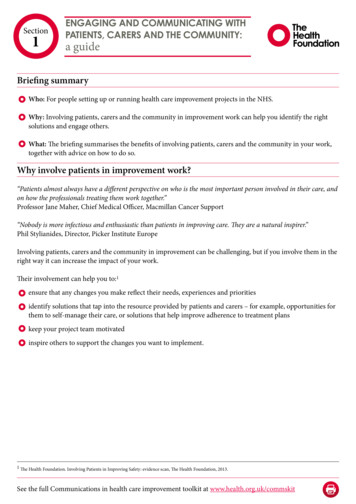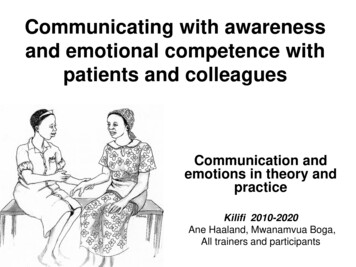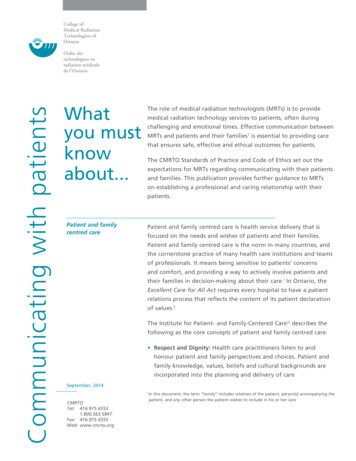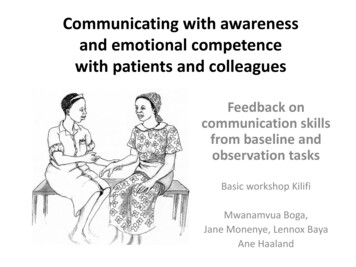
Transcription
Section1ENGAGING AND COMMUNICATING WITHPATIENTS, CARERS AND THE COMMUNITY:a guideBriefing summaryWho: For people setting up or running health care improvement projects in the NHS.Why: Involving patients, carers and the community in improvement work can help you identify the rightsolutions and engage others.What: The briefing summarises the benefits of involving patients, carers and the community in your work,together with advice on how to do so.Why involve patients in improvement work?“Patients almost always have a different perspective on who is the most important person involved in their care, andon how the professionals treating them work together.”Professor Jane Maher, Chief Medical Officer, Macmillan Cancer Support“Nobody is more infectious and enthusiastic than patients in improving care. They are a natural inspirer.”Phil Stylianides, Director, Picker Institute EuropeInvolving patients, carers and the community in improvement can be challenging, but if you involve them in theright way it can increase the impact of your work.Their involvement can help you to:1ensure that any changes you make reflect their needs, experiences and prioritiesidentify solutions that tap into the resource provided by patients and carers – for example, opportunities forthem to self-manage their care, or solutions that help improve adherence to treatment planskeep your project team motivatedinspire others to support the changes you want to implement.1 The Health Foundation. Involving Patients in Improving Safety: evidence scan, The Health Foundation, 2013.See the full Communications in health care improvement toolkit at www.health.org.uk/commskit
Section1ENGAGING AND COMMUNICATING WITHPATIENTS, CARERS AND THE COMMUNITY:a guideHow to involve patients and carers in improvement workThe NHS Institute for Innovation and Improvement has recommended the following touchstones for patientinvolvement:Involve patients from the very beginning and at all stages.Before you start, gain the enthusiasm and commitment of all those who will have to improvethe way they do things.Make sure that people in the organisation, including key decision makers, know about your plans and willsupport any findings to improve practice.Make sure you learn as you go, so that you can do it better next time.Provide appropriate resources and support to all involved.2It is important to be clear from the outset about the roles patients, carers and the community might play in yourimprovement work.The Picker Institute is a charity with a long track record of making patients’ views count in health care. PhilStylianides from Picker says: “Before you begin, ask yourself: ‘Are you willing to be truly open and committedto involving patients or will you end up simply ticking a box?’ Even with good intentions, it is all too easy to findyourself working within fixed parameters that patients can’t meaningfully influence. Another common mistakeis to involve patients only at the beginning of a project. For the benefits to be realised, it must be a continuingcommitment.”It is also important to assess whether you have the skills, resources and capacity within your project team tolisten to – and build good two-way relationships with – patients, carers and the communities you might need toinvolve at each stage of the process. This might include providing support and training, and will almost certainlyinvolve some financial resource – for example, expenses for travel and refreshments.Many NHS Trusts have patient involvement teams that should be able to provide advice and guidance oninvolving patients. So make use of their expertise.2 NHS Institute for Innovation and Improvement. Improvement Leaders’ Guide to Involving Patients and Carers, NHS Institute for Innovation and Improvement, 2005.See the full Communications in health care improvement toolkit at www.health.org.uk/commskit
Section1ENGAGING AND COMMUNICATING WITHPATIENTS, CARERS AND THE COMMUNITY:a guideMethods of patient involvementYou can involve patients, carers and members of your community in your improvement work on any offour levels:1 Enabling them to play a formal role on governance, steering or advisory groups.2 Seeking their views on their experiences of their care, and on how care can be improved.3 Involving them in the design of any change or intervention.4 Helping you to win hearts and minds.Some of the main approaches are summarised below.1 Involving patients in steering your improvement workSome improvement teams create formal roles for patients or patient representatives on project governance,steering or advisory groups. Success here can depend on:a) clearly defined roles, with a shared understanding of what’s expected of lay representativesb) clarity about which aspects of the work they can influencec) the skills of the individuals involved, and their ability to influence and steer the management of a projectappropriately.Where health problems may prohibit individual patients from taking on extended commitments, representativesof patient organisations and charities can be better placed to champion their needs through a role on acommittee or advisory group. Charities like Macmillan Cancer Support often use trained patient advocates towork alongside patients and help them express their stories, priorities and needs.2 Listening to patients’ views and experiencesTo improve patient care, it is essential to understand patients’ experiences of current care provision. Patients’views can be gathered through a range of methods, including: 1-1 interviews, surveys, focus groups, patientdiaries, clinician-patient meetings, patient shadowing, listening events or even informal coffee mornings withmembers of a local patient support group.Gaining a more representative picture is much easier to achieve when there is a defined cohort of patients – iefor a specific service. Phil advises that improvement leads, working on projects involving multiple services,should start by focusing on the needs of patients at a site/service level, and then take the learning out further toexplore what the findings might mean for patients in other services.You may also need to secure patients’ written consent and/or seek ethical approval – for example, for theirinvolvement in research. You can seek the advice of your Local Research Ethics Committee (LREC). They will beable to provide advice on good practice and help you determine when LREC approval will be necessary.See the full Communications in health care improvement toolkit at www.health.org.uk/commskit
Section1ENGAGING AND COMMUNICATING WITHPATIENTS, CARERS AND THE COMMUNITY:a guide3 Involving patients in work to co-design servicesCo-design approaches encourage and empower patients to actively develop solutions that will improve patientcare. They blur the distinction between the user of a service and the person designing or developing it. Theseapproaches are founded on the belief that, by creating solutions together, service users and service designers willarrive at a better end result.Professor Jane Maher from Macmillan Cancer Support Maher says: “Co-design can help you really understandwhat happens to people throughout their treatment and what matters to them, but it also means giving up somecontrol. If you’re going to use co-design methods, you may have to stand by the solutions that patients identify, eventhough those solutions may not be what you originally intended.”4 Involving patients in communicating your improvement workIf you have involved patients, carers and members of the community meaningfully as your work develops,you should find you have established a pool of potential advocates that you can call upon to influence others.Recipients of Health Foundation grants have testified how powerful these advocates can be, with some sharingpatients’ stories to influence clinicians, and involving patients or carers as part of the team presenting atmeetings – for example, to commissioners, executives, other patients or local politicians.What others say“The patient perspective is key. Their voice is a very effective communications tool.”Michael Nation, Development Director, Kidney Research UK“When involving patients, it’s the detail that counts. If you’re asking patients to speak up in meetings, you will needto provide them with appropriate training and support. If you’re asking them to travel to events, you will need to payexpenses up front. If you develop recommendations on the back of your work with patients, make sure you tell themwhat you have decided so that they have an opportunity to respond.”Professor Jane Maher, Chief Medical Officer, Macmillan Cancer SupportSee the full Communications in health care improvement toolkit at www.health.org.uk/commskit
Section1ENGAGING AND COMMUNICATING WITHPATIENTS, CARERS AND THE COMMUNITY:a guideResourcesInvolving Patients in Improving Safety: evidence scan, The Health Foundation, nts-improving-safetyPerson-centred care resource centre, The Health Improvement Leaders’ Guide to Involving Patients and Carers, NHS Institute for Innovationand Improvement, edia/135286/involving patients and carers guide.pdfTransforming Participation in Health and Care, a guide for commissioners, NHS England, 2013/09/trans-part-hc-guid1.pdfA, Lank E, Maher J. Communities of Influence: Improving Healthcare through Conversations and Connections,Donaldson Radcliffe Publishing, 2011.The Pictor technique is a method for exploring the experience of collaborative working between professionalsand patients. Read the article The Pictor .shortNetworksThe Patient Experience Network is a not-for-profit network that supports members involved in improving theexperiences of patients.http://patientexperiencenetwork.org/The Coalition for Collaborative Care is an alliance of people who wish to see more progress in the move towardsmore person-centred health ee the full Communications in health care improvement toolkit at www.health.org.uk/commskit
you should find you have established a pool of potential advocates that you can call upon to influence others. Recipients of Health Foundation grants have testified how powerful these advocates can be, with some sharing patients' stories to influence clinicians, and involving patients or carers as part of the team presenting at










